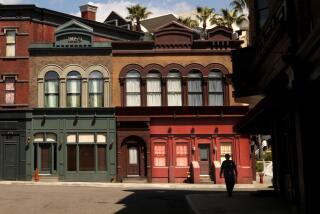A Second Look: ‘On the Bowery’
- Share via
Lionel Rogosin’s 1956 film “On the Bowery” is a time capsule in at least two senses: a portrait of a hand-to-mouth existence of a once-notorious New York City thoroughfare, as well as a glimpse into a largely forgotten byway of American documentary film.
The milelong stretch of Lower Manhattan known as the Bowery was a thriving entertainment district in the 19th century. But by the time of Rogosin’s indelible chronicle — which Milestone Films is issuing in a two-disc DVD this week, in both standard and Blu-ray editions — the neighborhood had long been in decline.
A skid row of gin mills, soup kitchens and flophouses, in the shadows of a soon-to-be-obsolete elevated railway, the Bowery of the mid-20th century was home to an assortment of itinerants and bums, many of whom could be found on any given morning slumped in doorways and sprawled on sidewalks. A pastor who appears in the film cites a newspaper report that calls it “the saddest and the maddest street in the world.”
Through the perspective of a newcomer named Ray (Ray Salyer), “On the Bowery” captures — without pity or judgment — the full extent of this sadness and madness, and suggests the perilous ease of falling into it. Ray, a strapping Southerner fresh off a railroad job in Jersey, shows up with a tattered suitcase, which he loses after a night of hard drinking. He befriends the grizzled barflies (including a cirrhotic geezer named Gorman), loiters on street corners in the hope of finding day work and swears off booze only to fall off the wagon again.
Shooting in vivid black-and-white, Rogosin and his cinematographer Richard Bagley find tough realities everywhere they turn: men drowning their sorrows in cheap muscatel and Sterno; getting into late-night brawls in bars with sawdust floors; lining up for beds at the Salvation Army dormitories and settling for newspaper mattresses in the basement.
It’s startling now to realize that “On the Bowery” was nominated for a documentary feature Oscar. Rogosin’s film is more accurately considered a hybrid of fiction and nonfiction — he described his method as “molding reality into a form that could touch the imagination of others.” While Salyer was a hired actor (who had a few things in common with his character, including a drinking habit), everyone else in the film was a Bowery resident.
Rogosin and his collaborators arrived with a loose fictional framework, and the film advances its perfunctory plot through a combination of documentary footage (shot at times with hidden cameras) and staged and improvised scenes.
The local reviews were mixed. The Village Voice praised the film’s “poignant shots and terrible insights.” But New York Times reviewer Bosley Crowther faulted it for seeming “consciously directed.” He also questioned the very point of this slice-of-lowlife movie: ‘You can see the same thing in many places without going too far from where you live.”
Rogosin’s aim was precisely to show people and places that many of his viewers would have been aware of but might have preferred not to see. This comes across most palpably in the closing montage of weathered faces, staring implacably into the camera — it’s a sequence that can only be called confrontational, but in the most humane sense of the word.
“On the Bowery” invites the present-day viewer to contemplate the distance between then and now. The Bowery today is not just cleaned up but gentrified beyond recognition: a yuppie playground of high-rise condos, luxury hotels and upscale restaurants.
Rogosin’s film also seems unthinkably remote from what we now consider documentary. “On the Bowery” follows in the pioneering tradition of Robert Flaherty, who used reenactments in his documentaries, and upholds the political commitment of the neorealists, who were finding and creating drama in the rubble of postwar Italy.
The documentary field would soon be transformed with the advent of cinéma vérité and its insistence on a style and technique that implied an unvarnished truth. The poetic realism of “On the Bowery” — or its Los Angeles counterpart, Kent MacKenzie’s “The Exiles,” about the Native American community in Bunker Hill — was channeled instead into fiction films, most clearly in the work of John Cassavetes, a fan of Rogosin’s.
The Milestone disc includes supplements that flesh out the fates of the film’s key personnel. Rogosin, who died in 2000, went on to run the Bleecker Street Cinema, a New York repertory house, and he made a few more films, including “Come Back Africa” (1959, about apartheid in South Africa) and the antiwar Vietnam-era “Good Times, Wonderful Times” (1966, included on the disc).
As for the actors, Gorman Hendricks, who had agreed to curb his drinking while the film was being made, promptly went on a fatal binge as soon as shooting wrapped. Salyer received a few Hollywood offers but turned his back on the industry; he hopped on a train one day and was never heard from again.
More to Read
The biggest entertainment stories
Get our big stories about Hollywood, film, television, music, arts, culture and more right in your inbox as soon as they publish.
You may occasionally receive promotional content from the Los Angeles Times.










